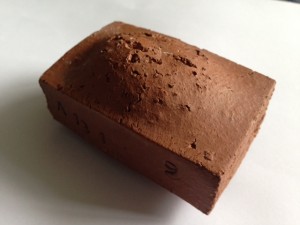What is the relationship between this curio and sustainability?
Curio courtesy of Prof Colin Hughes. School of Earth, Atmospheric and Environmental Sciences
Research interests: Applied environmental and petroleum geology and mineralogy, sustainable management and regulation
Teaching includes Environmental Impact Industry Projects: Copper Mining and Nuclear Power
My Curio Challenge is a deformed miniature house brick. I was sat in my office trying to be creative and come up with an idea for an exemplar Curio Challenge, and there it was right under my nose. I use it as a topic for discussion in tutorials. For me it represents so many facets of the sustainability agenda: from climate change, natural resource exploitation and toxic emissions pollution, to social equity, technological innovation and waste management.
After air, water and food, we all need shelter to survive, and baked bricks have been a ubiquitous building material for thousands of years. Bricks are made from clay bearing rocks and sediments which are blended and mixed before being shaped and baked. The bricks are heated to temperatures high enough to partially melt the raw materials, and most commonly the source of energy is fossil fuels. This is a test brick, from Adswood brickworks in Stockport, which has been fired to check the quality of raw materials. The brick has ballooned out of shape because of volatile, and potentially toxic impurities that have caused gas bubbles to form inside. Brick making is a major contributor to carbon emissions globally, second only to cement in the building materials sector. In addition to producing huge amounts of CO2 emissions, both brick and cement manufacture produce toxic gases which need to be ‘scrubbed clean’ before release to the atmosphere. In the developed world high tech. kilns optimise the use of natural gas and minimise pollution, whilst in the developing world dated and dirty coal firing methods are still commonly used. These are inefficient and highly polluting, and work conditions for labourers can be appalling and cruel. There is also a link to municipal solid waste disposal. Throughout the world exhausted clay pits are used to tip waste, and in recent decades biogas from decomposing waste in waste filled clay pits has been used to the supplement natural gas in brick kilns.
- Susan Brown asked 10 years ago
- last edited 10 years ago
- You must login to post comments


